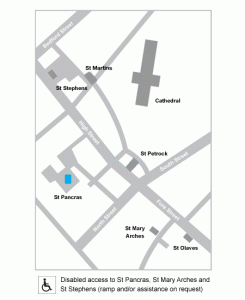 The present Parish of Central Exeter, shown in the map on the left, is served by six medieval parish churches: St Martins, St Mary Arches, St Olaves, St Pancras, St Petrock, and St Stephens, all of which were active at the time of Plague of a Green Man, the second novel in my Lady Apollonia West Country Mysteries:
The present Parish of Central Exeter, shown in the map on the left, is served by six medieval parish churches: St Martins, St Mary Arches, St Olaves, St Pancras, St Petrock, and St Stephens, all of which were active at the time of Plague of a Green Man, the second novel in my Lady Apollonia West Country Mysteries:
St Martins and St Petrock, on the Exeter Cathedral Close are discussed in my posting of December 19, 2016. Saint Mary Arches was popular as a place of worship with the Mayor of Exeter and many merchants from the 14th to the 16th centuries. Saint Olaves was founded in the 11th century and dedicated to Saint Olaf, a Viking king who converted to Christianity. It was rebuilt in the late 14th century. Saint Pancras, now in the heart of the modern Guildhall Shopping Centre, is largely 13th century Gothic construction with an 11th century baptismal font. This church is the oldest Christian site in Exeter. Saint Stephen’s Church was mentioned in the Domesday Book in the 11th century and is built on top of a crypt dating back to Saxon times.
Three other parish churches of medieval Exeter must also be mentioned. Saint Mary Major, begun in the 7th century, was located next to the west front of the cathedral as a minster, meaning a large or important church. It was converted to a parish church around 1220 when the Norman cathedral was built. That parish church was demolished in 1970 and an archaeological dig beneath it at that time revealed that it had been built over the site of a large Roman bathhouse. Saint Mary Steps is located at the foot of Stepcote Hill and was originally built in the 11th century though rebuilt in the 15th. It was once known as Saint Mary Minor in contrast with Saint Mary Major next to the cathedral. Finally, Saint Edmunds was just outside the West Gate of the City and may have gone back to Saxon times. Its 13th century version was single celled and located on the east end of the medieval bridge across the River Exe. Its remains are a ruin today at the end of those arches of the medieval bridge that survive.
For more on Exeter’s medieval churches, click on
http://www.exetermemories.co.uk/ or
https://www.wikipedia.org/ and search for individual churches.
Tags: Chaucer's England, historical fiction, medieval mysteries